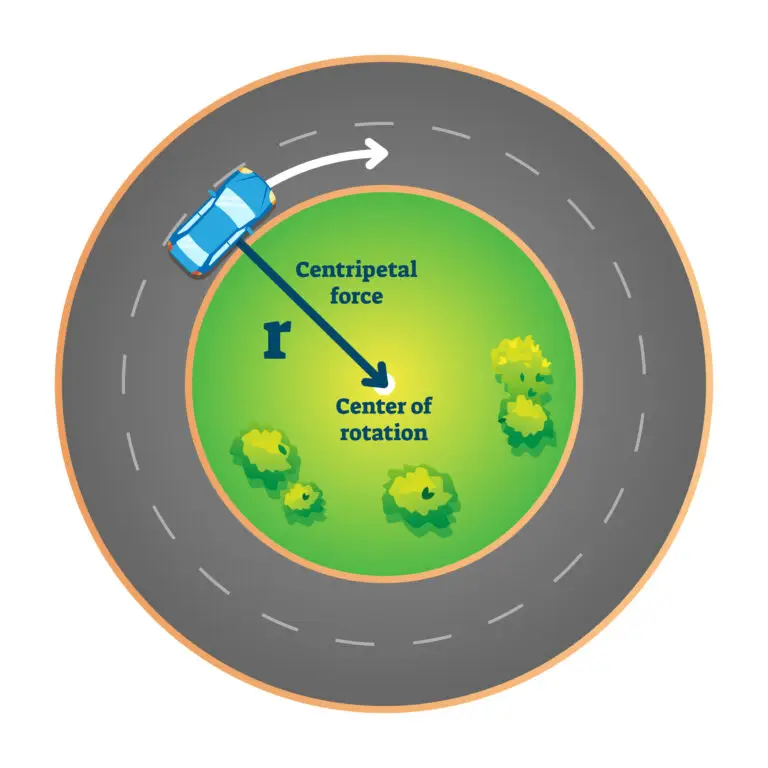Centripetal Force

Table of Contents
What is Centripetal Force?
The centripetal force acts perpendicular to the direction of an object’s velocity and towards the center of the circle around which the object is moving. This inward force continuously alters the direction of the object’s velocity, causing it to move in a circular path. Although the object’s speed may remain constant, its velocity continuously changes direction due to this force.
The centripetal force does not change the object’s speed (magnitude of velocity) but constantly changes its direction of motion. This is why it is associated with circular motion. The force acts along the radius of the circular path, pulling the object toward the center and preventing it from moving in a straight line tangent to the circle.
How Centripetal Force Works?
Centripetal Force Formula
The mathematical representation of centripetal force (F_c) required to maintain an object’s circular motion is derived from Newton’s second law of motion. The formula for centripetal force is:
\Large F_c=\frac{mv^2}{r}
where:
- m is the mass of the object,
- v is the tangential velocity or speed of the object in the circular path,
- r is the radius of the circle.
Here’s how the formula is related to Newton’s second law (F=ma):
The acceleration in circular motion is centripetal (a_c), which is directed toward the circle’s center. Its magnitude is given by a_c=\frac{v^2}{r}, where v is the object’s speed and r is the circular path’s radius.
Substituting the expression for centripetal acceleration into Newton’s second law, F=ma, we get the centripetal force F_c=m\times \frac{v^2}{r}
Origin of Centripetal Force
Centripetal force is intimately linked with the concept of inertia, which is the tendency of an object to resist changes in its state of motion. Inertia is the property of an object that keeps it moving in a straight line at a constant speed when no external force acts on it. In circular motion, an object’s inertia would naturally lead it to move off in a straight line tangent to the circle at any point on its path.
The centripetal force comes into play to counteract this inertial tendency. It continuously acts perpendicular to the object’s instantaneous velocity (tangent to the circular path) and toward the center of the circular path. This force constantly changes the direction of the object’s velocity, curving the path of the object into a circle while its speed remains constant.
The continuous action of the centripetal force changes the direction of the object’s velocity vector, keeping the object in circular motion. Although the speed (the magnitude of the velocity) of the object may remain constant, the velocity (the speed and direction) changes due to this continuous change in direction.
Relation to Acceleration
Centripetal acceleration is a key concept in circular motion. It represents the acceleration that keeps an object moving along a circular path. It is directly linked to centripetal force and is essential for maintaining an object’s circular trajectory.
Centripetal Acceleration (a_c) Formula: The centripetal acceleration of an object moving at a constant speed (v) along a circular path with radius (r) is calculated using the formula:
\Large a_c=\frac{v^2}{r}
This equation shows that centripetal acceleration is proportional to the square of the object’s speed and inversely proportional to the circle’s radius.
Newton’s second law of motion (F=ma) relates centripetal force and centripetal acceleration. The centripetal force (F_c) required to produce centripetal acceleration is F_c=m\times a_c, where m is the mass of the object. This relationship underscores that the force needed to keep an object in circular motion increases with the object’s mass and the square of its speed and decreases with the circle’s radius.
Centripetal Force in Mechanics
In mechanics, the concept of centripetal force is fundamental for analyzing the motion of objects following curved or circular paths. This analysis is crucial for understanding phenomena such as the orbits of planets and satellites, the motion of electrons in atoms, and the operation of mechanical systems like centrifuges.
Engineers must consider centripetal force when designing rotating machinery and systems, such as turbines, engines, and wheels. Ensuring these systems can withstand the forces generated by their circular motion is essential for their safe and efficient operation.
Components in rotating machinery are subjected to forces that can affect their structural integrity and function. Accurate calculations of centripetal force are necessary to design components that can withstand these forces without failing.
From the design of amusement park rides to the development of automotive and aeronautical technology, centripetal force considerations are integral to ensuring the safety and functionality of a wide range of engineered systems.
Examples of Centripetal Force
Circular Motion of Planets
In our solar system, planets orbit the Sun due to the gravitational pull of the Sun acting as a centripetal force. This force keeps the planets moving in their elliptical orbits, preventing them from flying off in a straight line. The gravitational attraction between the Sun and a planet provides the necessary centripetal force to maintain each planet’s orbital path.
Rotating Objects
Common examples include a ball tied to a string and swung in a circular motion or a spinning top. In these cases, the tension in the string (for the ball) or the force exerted at the point of contact (for the top) acts as the centripetal force, pulling the object inward toward the axis or point of rotation and keeping it moving in a circle.
Car Turning
When a car makes a turn, the friction between the tires and the road surface provides the centripetal force needed for the car to follow a curved path. This force acts perpendicular to the direction of the car’s velocity and inward toward the center of the turning curve, allowing the vehicle to change direction while maintaining its speed.
Centripetal Force Calculator
Instructions: Input the mass, velocity, and radius to calculate the centripetal force.
Related Links
Acceleration
Inertia
Momentum
Torque